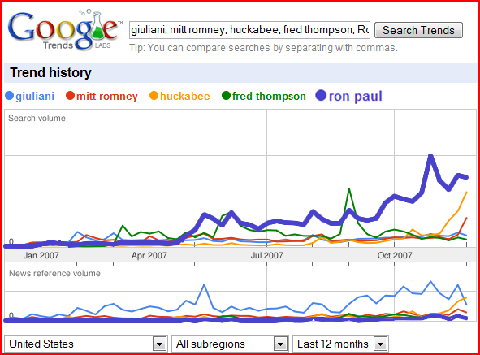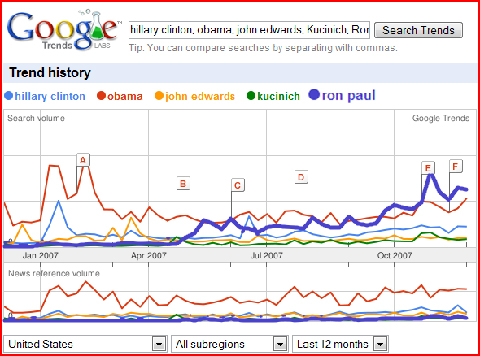Hyper customized video, voice, language
In my last video post I said that hyper customized video is an area for innovation. Here is an example of some emerging technology. http://cubo.cc/ The realistic animation of a woman responds to the movement of your mouse. Combine that with face tracking of a web camera and voice chat and you could literally put on a new face to talk to different people. Text to speech software like ReadPlease uses a phoneme based system to let you choose the voice. A&TT Natural Voices is virtually indistinguishable from a person talking. Voice recognition and automated language translation could allow you to appear to be anyone you want to be. And the viewer might be able to select how you sound and appear to them.
Ron Paul Viral Marketing Success
Ron Paul is winning popularity portion of the united States presidential election. He consistently speaks the truth and does what he says. And lucky for Ron Paul the truth makes a lot of people so happy they sell his message for him.
I pioneered viral media on the web. And have since moved beyond viral to a broader more accurate term, evangelism. Its clear Ron Paul has a lot of evangelists. All of his success is from normal people spreading the message all on their own.
Part of my research on viral / evangelistic marketing is what the trends mean and how to get the results you want. Looking at the trends for Ron Paul and the other candidates I see some very striking results.
Google Trends is accurate unbiased data on what real people actually care about. According to Neilsen/NetRatings 232 million Americans use the Internet. That makes Google Trends the largest most accurate measure in the world.

First, Ron Paul (dark blue line) has more searches than than any other candidate. Plus his searches is continually growing. This is suggestive of real wide spread support. There are 7.7 million pages on Google for Ron Paul.. That is almost 4 times as many as Mitt Romney. Ron Paul has more pages about him, which confirms support not just interest. There are other measures I use and will explain those in future posts.
Romney (orange line) has no real support. You can see this from how his traffic jumps then immediately falls to nothing. He depends on events to get any interest. If Romney was a company I would short his stock. His advertising works but Romney is a bad product.

Hillary Clinton (the red line) is suffering from the same problem as Mitt Romney. She gets big spikes but people don’t like her and try to forget her as soon as possible. Even with a huge budget and over 16 years of national media attention there are only 5.8 million pages talking about her. And much of that is criticism. Hillary Clinton is the political equivalent of Paris Hilton. She gets attention when she does something insane but loses popularity every time.
Barack Obama is in bad shape. Notice that he got a big jump when he announced he was running for office but his traffic has consistently gone down. With only 2.8 million pages and downward trend Barack Obama he is far behind the leader, Ron Paul. The fact Obama doesn’t get any new jumps means its unlikely he will gain any support. He could linger around for a long time but will have a hard time getting new attention. He is played out.
My Suggestions
Hillary has total name recognition. Since people react so negatively she can’t really benefit from Evangelism Marketing without doing something very different. With her long track record she would face the credibility issue if she tried to be different. She depends on spending huge amounts of money and favorable treatment from the big press to get attention.
Romney is dead in the water. He needs to find something unique that he actually deliver. Unfortunately that would require going back in time. He can’t deliver anything unless elected.
Obama can make it to the election with his current trend. He needs to find a new audience, which is unlikely since he already had a huge jump in the beginning. If he offers something new that might get more attention.
3D Printer Brings Vision to the Poor
The same week that I found all the articles on 3D printers I found an amazing example that could dramatically improve life for billions of people in developing countries who cannot access, nor afford, prescription glasses.
Last weekend I went to get a new optical prescription so I could buy new contacts. The technician used fully automatic devices to check me for glaucoma and calculated my prescription. I had experienced the glaucoma device but the prescription device was new to me. I instantly knew how it worked just from seeing it. The machine reflects a pattern off your eye then adjusts lenses in the device until the reflected pattern matches the original. Incredibly, quick easy and cheap!
My mind raced through all the potential innovations stemming from this device. I came up with a long list which I’ll get to in a moment. What I am more excited about is an extremely innovative application of this same technique. In 2002 a student at MIT used a similar technique as part of a system to make glasses for the poor. This was exactly what I had thought of. This innovation went from an idea in 2002 to commercial usable device in 2006. That is amazing.
One of the reasons the idea was developed in such a short time was the use of a 3D printer to create a prototype. But probably even more important was it solved a previously impossible problem and opened up a gigantic market. There are 1 billion people who need inexpensive glasses. 
There are two obstacles to providing eye glasses to people in developing countries. Read more



 Predictive Innovation Training
Predictive Innovation Training Predictive Innovation: Core Skills Book
Predictive Innovation: Core Skills Book RoundSquareTriangle.com
RoundSquareTriangle.com